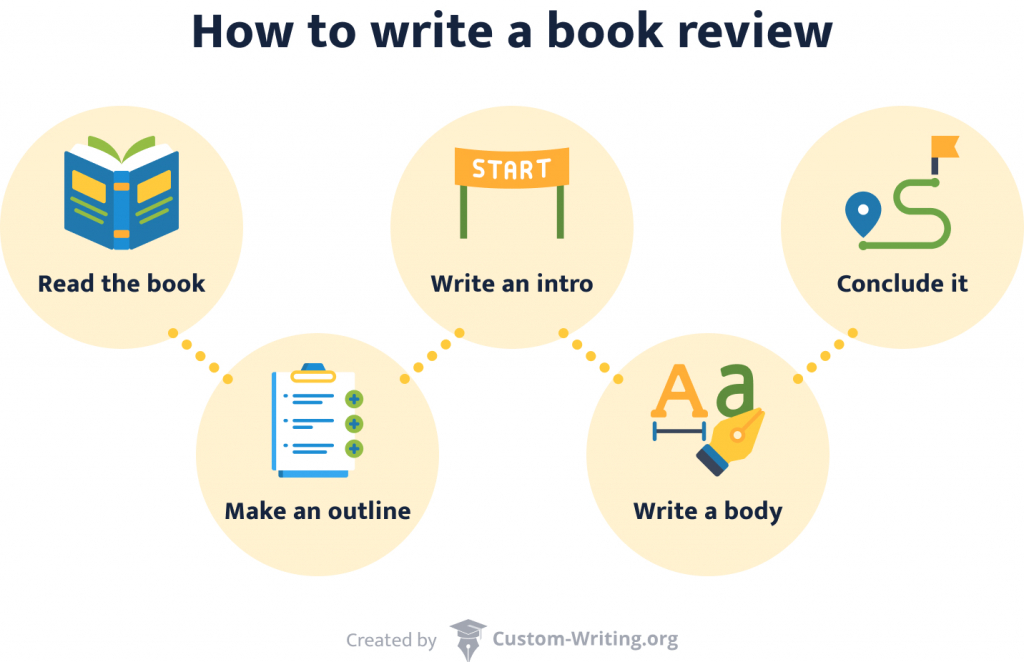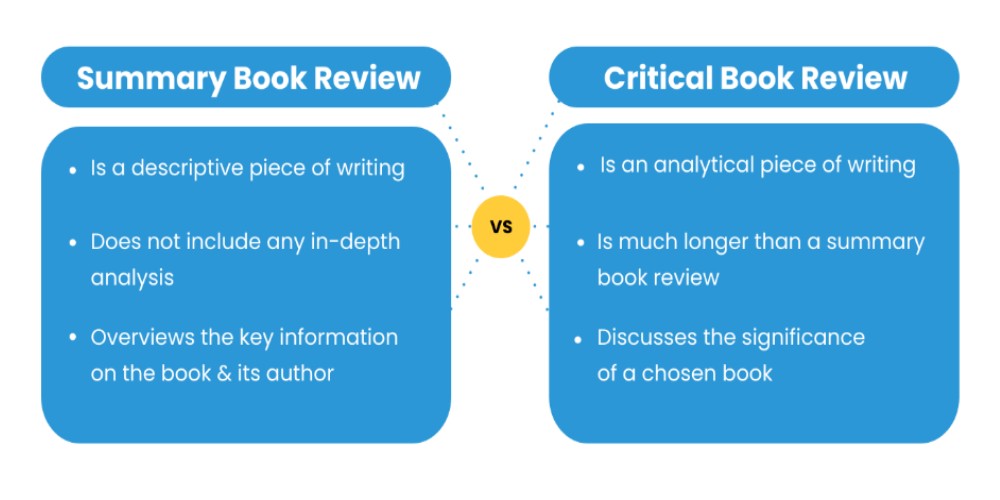With a good book review outline example, you are sure to structure your thoughts properly, covering all critical aspects of the work under examination. Whether you’re looking for a book review outline template or guidance on how to write a book review, examples with a solid framework will simplify the process and improve the final result.

A typical outline for a book review includes:
- An introduction with the book’s title, author, and a brief summary
- An evaluation of key elements such as themes, characters, and writing style
Read this post by Custom-Writing.org to learn all about book review writing and grab an excellent outline template.
While this guide is a great starting point, crafting a book review can sometimes be more challenging than it seems. Two of the most complicated cases are:
- A book with a twisting plot and complex narrative: Offering meaningful insights without giving away spoilers can be tricky.
- A book you either extremely like or dislike: Maintaining balance, fairness, and objectivity is no easy task if the book has emotionally impacted you in some way.
If any of these cases sound like yours, or if you simply want to save time and energy for other tasks, you can always rely on our book review writing service.
❓ What Is a Book Review?
A book review is a form of literary criticism. There are several important elements to consider when writing one, such as the author’s style and themes of interest. The two most popular types are short summary reviews and critical reviews, which are longer.

Summary Book Review
The format of a book review depends on the purpose of your writing. A short summary review will not include any in-depth analysis. It’s merely a descriptive piece of writing that overviews key information about the book and its author. An effective summary review consists of:
- Reference to a chosen book in the form of a citation.
- A few words on the book’s purpose.
- Description of the main themes, ideas, and issues highlighted by the author.
- Brief information about other works on this topic, if applicable.
- A note about the author and visual materials of the book, along with its structure.
Critical Book Review
A critical book review is much longer than its summary counterpart and looks more like an analytical essay. You may be asked to write one as a college student. It includes:
- Book citation and a hook in the introduction.
- A few words about the author’s intentions.
- An academic description of the main ideas and themes.
- Mention of errors in the text, if you found any.
- Discussion of the chosen book’s significance and how it has influenced the field.
- Some information about the author and the physical content of the book.
- Description of the audience and whether the writer’s style and ideas are engaging.
🧩 Book Review Outline
Check out the book review outline template below to learn more about structuring your paper.
Introduction
The introduction of a book review should include some background information and your thesis statement.
- What is this book about?
- Who is the author?
- What were the reasons for writing this book?
- Who is this book for?
- What is the general problem the book addresses?
Brief book summary
A brief summary should provide an outline of the book’s main ideas or events.
- What are the main themes/ideas of the book?
- What is the plot?
- Who are the characters?
- What is the major emphasis of the work?
Critical review
A critical review should focus on your evaluation of the author’s approach to writing about a particular issue.
- What did you like/dislike in the book?
- What are the book’s strengths and weaknesses?
- What do you agree/disagree with? Why?
- How does this book compare to other books on this topic?
- What matters does the book leave out?
Conclusion
The conclusion of a book review should finish with your personal assessment of the work.
- Has the author achieved the purpose of writing the book?
- Is this book worth reading?
- To whom would you recommend this book?
- What is your final opinion about it?
- What steel needs to be written on this subject?
Book Review Outline Example
We have prepared for you a book review outline example on Looking for Alaska by John Green. Check it out:
- Introduction
- Hook: Have you ever searched for meaning amidst the chaos of teenage life? John Green’s Looking for Alaska embarks on that very journey, unveiling the messy realities of adolescence.
- Overview of the book.
- Information about the author.
- Thesis statement: In Looking for Alaska, John Green skillfully crafts a narrative that delves into the turbulent journey of adolescence, exploring themes of friendship, identity, and the quest for meaning.
- Brief book summary
- Introduction of the protagonist, Miles Halter.
- Introduction of other characters and their roles in Halter’s life.
- Key events of the book.
- Critical review
- Green’s writing style and its effectiveness in portraying the turbulent emotions and confusion of adolescence.
- The character development of Miles and his journey of self-discovery, grief, and understanding.
- Exploration of how themes of friendship, identity, and the quest for meaning are depicted throughout the narrative.
- Conclusion
- Restated thesis.
- Brief summary of main points.
- Recommendation: I would recommend this thought-provoking book to fans of realistic fiction that doesn’t shy away from difficult topics.
📋 Book Review Format
Here are several practical tips that can aid you in formatting your book review:
- Start with the book citation. Provide the necessary publication information about the book, including the author’s name, the full title of the book, and other elements required by your chosen citation style (e.g., APA, MLA, Chicago, etc.).
- Italicize the book title in the text. Whenever you mention the book title in your review, remember to type it in italics without using quotation marks. However, if you include the title of a book chapter, enclose it in quotation marks and don’t italicize it.
- Use a readable font. Type your book reviews using a 12-pt Arial or Times New Roman font.
- Apply standard document settings. These include 1-inch margins on all sides, double spacing, and flush left paragraph alignment.
- Use in-text citations. Always cite the information borrowed from other authors. This way, your readers will understand the origin of your ideas and distinguish your thoughts from those of others.
- Keep your review to 500-1500 words. When the professor does not indicate how many words to include in your book review, keep it to 2-5 double-spaced pages.
✍️ How to Write a Book Review?
The structure of a book review is like any other essay. That said, the process of writing one has its own idiosyncrasies. So, before moving to the three parts of the review (introduction, main body, and conclusion), you should study the chosen piece and make enough notes to work with.
Step #1: Choose a Book and Read It
Being interested in a book you’re about to analyze is one thing. Reading it deeply is quite another.
Before you even dive into the text proper, think about what you already know about the book. Then, study the table of contents and make some predictions. What’s your first impression?
Now, it’s time to read it! Don’t take this step lightly. Keep a note log throughout the reading process and stop after each chapter to jot down a quick summary. If you find any particular point of interest along the way and feel you might want to discuss it in the review, highlight it to make it easier to find when you go back through the text. If you happen to have a digital copy, you can even use a shorten essay generator and save yourself some time.
Answering the following questions can also help you with this process.
Step #2: Create Your Book Review Outline
A solid outline should be the foundation of any worthy book review. It includes the key points you want to address and gives you a place to start from (and refer back to) throughout the writing process.
You are expected to produce at least five paragraphs if you want your review to look professional, including an introduction, three body paragraphs, and a conclusion.
While analyzing your notes, consider the questions below.
Step #3: Write Your Book Review Introduction
With a layout firmly in place, it’s time to start writing your introduction. This process should be straightforward: mention the name of the book and its author and specify your first impression. The last sentence should always be your thesis statement, which summarizes your review’s thrust and critical findings.
Step #4: Write Your Book Review Body
Include at least three main ideas you wish to highlight. These can be about the writing style, themes, character, or plot. Be sure to support your arguments with evidence in the form of direct quotes (at least one per paragraph). Don’t be afraid to paraphrase the sentences that feel off. It’s better to aknowledge the mistakes yourself than have someone else point them out.
Step #5: Write Your Book Review Conclusion
Compose a brief summary of everything you wrote about in the main body. You should also paraphrase your thesis statement. For your closing sentence, comment on the value of the book. Perhaps it served as a source of useful insight, or you just appreciate the author’s intention to shed light on a particular issue.
👀 Book Review Example
Now you know how to write a book review. But if you need some more inspiration, check out the following sample review, which follows the basic outline described above.
Mary Shelley’s Frankenstein: Book Review Example
If you want more examples, check out the list below!
- “The 21 Irrefutable Laws of Leadership”: Book Review
- The Great Gatsby: A Book Review and Summary
- Book Review: “They Say I Say”
- Book Review “Religious, Feminist, Activist ” by Laurel Zwissler
- “Tell My Horse” by Zora Neale Hurston Book Review
- “Emotional Intelligence” by Daniel Goleman Book Review
Book Review Essay Topics
- Pride and Prejudice by Jane Austen: book review.
- The symbolic nature of the Canadian consumption culture in The Donut: A Canadian History by S. Penfold.
- The key lessons of the book Rich Dad Poor Dad by Robert Kiyosaki.
- Big Talk, Small Talk by Shola Kaye: a guide to effective communication.
- Review of the book The Handmaid’s Tale by Margaret Atwood.
- The main ideas promoted in Thinking About Crime: Sense and Sensibility in American Penal Culture by M. Tonry.
- Exposition of young boys’ problems in Nikkah’s Our Boys Speak.
- Mrs. Dalloway by Virginia Woolf: book review.
- Discuss the message to future entrepreneurs in Phil Knight’s Shoe Dog.
- The main ideas of The 7 Habits of Highly Effective People by Stephen R. Covey.
- Magical realism in The Brief Wondrous Life of Oscar Wao by Juno Diaz.
- Book review: Into the Wild by Jon Krakauer.
- Psychological struggles of identity and isolation in Frankenstein by Mary Shelley.
- The principle of negotiation in the book Getting to Yes.
- Analyze the symbolism in Ray Bradbury’s Fahrenheit 451.
- The role of family in Montana 1948.
- Weaving the Web by Tim Berners-Lee: book review.
- Discuss the main topic of the book Death of a Salesman.
- Tragedy of the family in A Good Man Is Hard to Find by Flannery O’Connor.
- Realistic features of Afghanistan in The Kite Runner by Khaled Hosseini.
- Review of the book Montley Fool Money Guide.
- Description of the gap between two cultures in The Spirit Catches You and You Fall Down by Anne Fadiman.
- The effect of Puritan beliefs in Nathaniel Hawthorne’s Young Goodman Brown.
- Heart of Darkness by Joseph Conrad as a prominent example of symbolism.
- The philosophical value of Oedipus the King by Sophocles.
- Discuss the description of gradual personality changes in Edgar Allan Poe’s The Black Cat.
- Review of the play Much Ado About Nothing by W. Shakespeare.
- Analyze the core theme of Sherman Alexie’s book The Absolutely True Diary of a Part-Time Indian.
- Family values and culture preservation issues in J.D. Vance Book Hillbilly Elegy.
- Problems of teenagers’ behavior in Nothing but the Truth by Avi.
- The role of women in society in Sylvia Plath’s The Bell Jar.
- Satire on the Victorian society customs in The Importance of Being Earnest by Oscar Wilde.
- Danger of obsession with new technologies in Nathaniel Hawthorne’s The Birthmark.
- Describe the controversial messages of Why Don’t You Dance by Raymond Carver.
- Examine the central problem of the novel Motorcycle Ride on the Sea of Tranquility by Patricia Santana.
- Review of the book Billy Budd by Herman Melville.
- The fundamental philosophical problems of perception and consciousness in The Invention of Morel by Adolfo Bioy Casares.
- Discuss the role of the illusory world Tennessee Williams’ The Glass Menagerie.
- Gender roles in A Doll’s House by Henrik Ibsen.
- Analyze the main topic of Death by Landscape by Margaret Atwood.


![How to Write an Argumentative Essay: 101 Guide [+ Examples]](https://custom-writing.org/blog/wp-content/uploads/2021/01/young-writer-taking-notes-284x153.jpg)
![How to Title an Essay: Examples & Step-by-Step Guide [2025]](https://custom-writing.org/blog/wp-content/uploads/2021/01/close-up-woman-making-greeting-card-new-year-christmas-2021-friends-family-scrap-booking-diy-writing-letter-with-best-wishes-design-her-homemade-card-holidays-celebration-284x153.jpg)

![How to Write a Good Introduction: Examples & Tips [2025 Upd.]](https://custom-writing.org/blog/wp-content/uploads/2021/01/closeup-shot-woman-working-studying-from-home-with-red-coffee-cup-nearby-284x153.jpg)

![How to Write about a Topic You Lack Interest in [2025]](https://custom-writing.org/blog/wp-content/uploads/2021/01/Frustrated-exhausted-young-woman-blogger-284x153.jpg)




I need a seven page Book report on Booker T. Washington. Instructions below from instructor
title, your name, and then seven paragraphs and seven pages – no more no less.
get rid of the outline format.
They combine your ideas into seven paragraphs.
Each paragraph that has quotes should have a topic sentence followed by the five sentences with quotes and endnotes, followed by the concluding sentence.
You do not need any quotes in the introduction or in the summary.
So seven paragraphs total.
Each paragraph needs to be 13 – 17 lines, lines on a page and not sentences.
So, delete the outline format.
Combine your ideas into seven paragraphs.
Make sure that each paragraph has between 13–17 lines.
And make sure your overall length is in seven pages, no more no less.